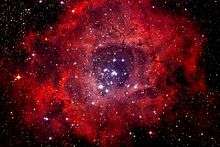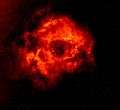Rosette Nebula
| Emission nebula | |
|---|---|
| H II region | |
 The Rosette Nebula (H-Alpha + RGB) | |
| Observation data: J2000.0 epoch | |
| Right ascension | 06h 33m 45s[1] |
| Declination | +04° 59′ 54″[1] |
| Distance | 5,200[2] ly (1,600 pc) |
| Apparent magnitude (V) | 9.0 |
| Constellation | Monoceros |
| Physical characteristics | |
| Radius | 65 ly |
| Notable features | Multipart nebula |
| Designations | SH 2-275,[1] CTB 21,[1] Caldwell 49 |
The Rosette Nebula (also known as Caldwell 49) is a large spherical H II region (circular in appearance) located near one end of a giant molecular cloud in the Monoceros region of the Milky Way Galaxy. The open cluster NGC 2244 (Caldwell 50) is closely associated with the nebulosity, the stars of the cluster having been formed from the nebula's matter.
The complex has the following NGC designations:
- NGC 2237 – Part of the nebulous region (Also used to denote whole nebula)
- NGC 2238 – Part of the nebulous region
- NGC 2239 – Part of the nebulous region (Discovered by John Herschel)
- NGC 2244 – The open cluster within the nebula (Discovered by John Flamsteed in 1690)
- NGC 2246 – Part of the nebulous region
The cluster and nebula lie at a distance of some 5,000 light-years from Earth[3]) and measure roughly 130 light years in diameter. The radiation from the young stars excites the atoms in the nebula, causing them to emit radiation themselves producing the emission nebula we see. The mass of the nebula is estimated to be around 10,000 solar masses.
A survey of the nebula with the Chandra X-ray Observatory has revealed the presence of numerous new-born stars inside optical Rosette Nebula and studded within a dense molecular cloud. Altogether, approximately 2500 young stars lie in this star-forming complex, including the massive O-type stars HD 46223 and HD 46150, which are primarily responsible for blowing the ionized bubble.[4][5] Most of the ongoing star-formation activity is occurring in the dense molecular cloud to the south east of the bubble.[6]
A diffuse X-ray glow is also seen between the stars in the bubble, which has been attributed to a super-hot plasma with temperatures ranging from 1 to 10 million K.[7] This is significantly hotter than the 10,000 K plasmas seen in HII regions, and is likely attributed to the shock-heated winds from the massive O-type stars.
Observing the Rosette Nebula
The cluster of stars is visible in binoculars and quite well seen in small telescopes while the nebula itself is more difficult to spot visually and requires a telescope with a low magnification. A dark site is a must to see it. Photographically the Rosette Nebula is easier to record and it is the only way to record the red color which is not seen visually.
Image gallery
 Optical and X-ray (red) view of the Rosette Nebula
Optical and X-ray (red) view of the Rosette Nebula Rosette Nebula -NGC 281- in narrowband Sulfur-Hydrogen Alpha-Oxygen modified Hubble palette with a 384mm scope
Rosette Nebula -NGC 281- in narrowband Sulfur-Hydrogen Alpha-Oxygen modified Hubble palette with a 384mm scope

 A close up view of the Rosette Nebula
A close up view of the Rosette Nebula The Rosette Nebula captured with an H-alpha filter
The Rosette Nebula captured with an H-alpha filter.jpg)
 NGC 281 in the classic Hubble Palette (Ha/OIII/SII)
NGC 281 in the classic Hubble Palette (Ha/OIII/SII)
See also
References
- 1 2 3 4 "NGC 2237". SIMBAD. Centre de données astronomiques de Strasbourg. Retrieved 2006-10-23.
- ↑ Phelps, Randy L.; Ybarra, Jason E. (2005). "A Parsec-Scale Outflow in the Rosette Molecular Cloud?". The Astrophysical Journal. 627 (2): 845–849. Bibcode:2005ApJ...627..845P. doi:10.1086/430431.
- ↑ 'Cambridge Deep Sky Companions - The Caldwell Objects' , S.J. O'Meara & P. Moore, Cambridge University Press, ISBN 0-521-82796-5 (2002)
- ↑ Kuhn, M. A.; et al. (2015). "The Spatial Structure of Young Stellar Clusters. II. Total Young Stellar Populations". Astrophysical Journal. 802 (1): 60. arXiv:1501.05300. Bibcode:2015ApJ...802...60K. doi:10.1088/0004-637X/802/1/60.
- ↑ Wang, J.; et al. (2008). "A CHANDRA STUDY OF THE ROSETTE STAR-FORMING COMPLEX. I. THE STELLAR POPULATION AND STRUCTURE OF THE YOUNG OPEN CLUSTER NGC 2244". Astrophysical Journal. 675 (1): 464–490. arXiv:0711.2024. Bibcode:2008ApJ...675..464W. doi:10.1086/526406.
- ↑ Ybarra, J. E.; et al. (2013). "THE PROGRESSION OF STAR FORMATION IN THE ROSETTE MOLECULAR CLOUD". Astrophysical Journal. 769 (2): 140. arXiv:1303.1226. Bibcode:2013ApJ...769..140Y. doi:10.1088/0004-637X/769/2/140.
- ↑ Townsley, L. K.; et al. (2003). "10 MK Gas in M17 and the Rosette Nebula: X-Ray Flows in Galactic H II Regions". Astrophysical Journal. 593 (2): 874–905. arXiv:astro-ph/0305133. Bibcode:2003ApJ...593..874T. doi:10.1086/376692.
External links
| Wikimedia Commons has media related to Rosette Nebula. |
- Rosette Nebula (SEDS)
- Chandra Observatory study of the Rosette Nebula
- NOAO; "Fitful Young Star Sputters to Maturity in the Rosette Nebula"
- NightSkyInfo.com – Rosette Nebula
- Astronomy Picture of the Day
- Dust Sculptures in the Rosette Nebula – 2007 June 6
- Dust Sculptures in the Rosette Nebula – 2009 December 2
- Field of Rosette – 2010 February 14
- Slooh Videocast on Rosette Nebula
- Rosette Nebula from the Netherlands
- Deep image of the Rosette Nebula
- The Scale of the Universe (Astronomy Picture of the Day 2012 March 12)
- Rosette Nebula on WikiSky: DSS2, SDSS, GALEX, IRAS, Hydrogen α, X-Ray, Astrophoto, Sky Map, Articles and images
- Rosette Nebula at Constellation Guide